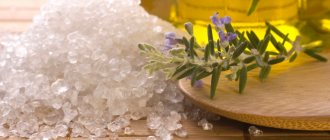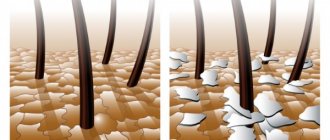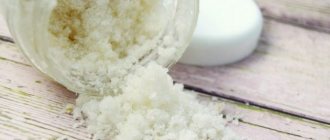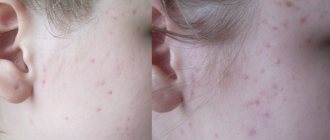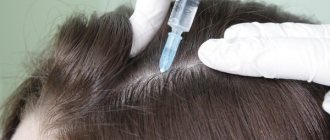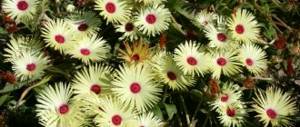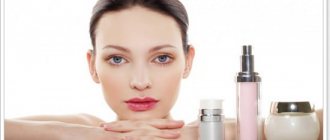Are there any benefits to scalp exfoliation?
The benefits of cleansing the scalp are undeniable. Thanks to the mechanical and chemical effects of special products on the skin, deep cleaning of pores and saturation of tissues with oxygen occurs, which has a beneficial effect on hair growth and helps strengthen it.
Main benefits of peeling:
- removal of contaminants;
- removal of sebaceous gland derivatives;
- removal of cosmetic residues;
- improving blood circulation;
- increasing the tone of the scalp;
- stimulation of cellular metabolism;
- deep nutrition of hair follicles in the future;
Scalp peeling is an excellent procedure that improves the condition of the skin and hair. - acceleration of hair growth.
Can my head hurt after peeling?
You need to know that after peeling, the cellular metabolism of the scalp is restored. As a result, the next day after some types of peeling, you may experience a slight itching or even burning sensation, which may be accompanied by a mild headache. At the same time, there is absolutely no need to worry, because such procedures stimulate skin tone and make it work to improve hair growth. After just a few days, all negative symptoms disappear and do not return.
Scalp peeling is a must for women and men regularly, because regular shampoos cannot fully cope with the problem of exfoliation of skin cells. This procedure will get rid of many other problems, enhance hair growth, making it more beautiful, stronger and healthier.
Types of scalp peeling that can be done at home
There are several types of peelings, each of which differs in nature and method of implementation. Most types of procedures are carried out in a beauty salon.
There are the following types of peeling:
- mechanical;
- chemical;
- gas-liquid (hardware).
In turn, chemical peels are divided into:
- fruit;
- enzymatic;
- biological.
Hardware peeling includes:
- galvanic peeling;
- aqua peeling;
- ozone peeling.
Of all the possible options, mechanical and fruit peeling can be done at home. Mechanical peeling - cleansing the scalp using products with abrasive particles (scrub or gunnage). In addition to solid particles, peels usually include vitamin and mineral complexes.
Therefore, the procedure not only cleanses the upper stratum corneum, but also promotes deep nourishment of the skin. The procedure takes the form of a relaxing scalp massage using a scrub that is rubbed into the area of the hair follicles.
Fruit peeling is classified as chemical. Its essence lies in the use of a mixture of fruit and synthetic acids, which have a gentle effect on the scalp and cleanse it. The mixture can be purchased at the store or prepared yourself using a paste made from fruit.
Types of hair peeling
There are several peeling options, differing from each other in the nature of the effect and method of implementation.
Acidic or chemical
Acid peeling is divided into types:
- biological;
- fruit;
- enzymatic.
The essence of chemical cleansing is that the dermis of the head is affected with the help of acids (lactic, tartaric, malic).
Important! Chemical peeling is contraindicated for pregnant women and nursing mothers.
Fruit
It is carried out with fruit acids and is available for home performance. This cleansing gently exfoliates dead cells and refreshes the skin.
Enzymatic
The active cleansing components are not acids, but enzymes, so enzyme peeling is considered a gentle procedure.
Mechanical
This option involves treating the skin with scrubs or gommage. The products are applied with massaging movements and rubbed into the head. Salt peeling is recommended for home use.
Hardware
Gas-liquid peeling is a hardware procedure, or otherwise aqua-peeling . An innovative non-contact cleansing technique based on treating the skin with a solution of medications, oxygen and carbon dioxide.
The device allows you to deliver the solution at supersonic speed, which saturates the dermis with useful microelements and effectively exfoliates the stratum corneum .
Peculiarities of peeling according to skin type
Each hair type has its own nuances in care. Therefore, to achieve maximum effect, you should choose the type of procedure depending on the characteristics of your hair.
Fat
Oily scalp is characterized by excessive production of subcutaneous sebum. Peeling for this skin type requires a careful preparatory stage, otherwise the effect of the procedure will be minimal. Before peeling, it is necessary to cleanse the skin of sebaceous contaminants using a scrub and only then proceed with the necessary manipulations.
Dry
When choosing the type of peeling for dry skin, you should give preference to components that will not overdry it.
You should also limit the number of procedures performed. It is recommended for those with dry hair and skin to carry out the procedure no more than once every 10 days. After the course, a two-month break is required and can be repeated again.
Sensitive
For those with sensitive scalp, you need to be careful when carrying out the cleansing procedure. It is necessary to select the most gentle compositions of peeling complexes so as not to harm the skin.
Most often, peelings based on fruit acids or hardware peels are used in a beauty salon. It is not recommended to carry out the procedure more often than once a month.
For hyperkeratosis
Skin hyperkeratosis is a pathological thickening of the skin resulting from untimely exfoliation of keratinized cells. Peeling for hyperkeratosis should be more aggressive in order to achieve the maximum effect of the procedure.
Chemical peels are best suited for this purpose, the effect of which is similar to the natural regeneration process. Peeling gently but deeply affects the skin and promotes cleansing without the risk of damage.
What can you add to salt peeling?
You can enhance the beneficial effect of the procedure by including active ingredients in the composition, which will also benefit the hair and skin:
Olive oil in the scalp scrub deeply nourishes and moisturizes them from the inside. Vitamins and fatty acids contained in the oil soften the effect of the scrub.- Burdock oil ensures growth and nutrition of deep hair structures, and also stimulates the development of new hair follicles.
- Blue, white and black clay have an additional cleansing effect on excessively oily hair, making it manageable and maintaining freshness for a long time.
- Aloe juice has a powerful antioxidant effect, nourishes with vitamins and microelements.
- Essential oils of rose, orange, rosemary, tea tree, bergamot, ylang-ylang, lavender, mint, eucalyptus, pine contain vitamins and microelements that are beneficial to the condition of curls.
- Decoctions of herbs such as nettle, chamomile, lovage, birch buds, hops, burdock root, calendula, and laurel can be used in hair scrubs, increasing the effectiveness of the procedure.
How to peel correctly
Scalp peeling requires careful preparation and compliance with all necessary stages.
Main details of the procedure:
- peeling is carried out on damp hair before washing your hair with shampoo;
- The peeling agent is applied exclusively to the root zone;
- application of the solution to cleanse the skin is carried out using light massage movements;
- purchased peeling products are used exclusively in accordance with the instructions indicated;
- rinsing hair after the procedure is carried out using warm, not hot water;
- a feeling of discomfort during peeling is the reason for stopping the procedure as soon as possible.
Post-peeling care
After the procedure, be sure to use nourishing masks, shampoos and balms that will help restore the structure of the hair and skin cells. The best person to choose the right product for you is a professional, whom you should definitely contact for advice before starting peeling.
Immediately after peeling, apply a restorative product.
Cosmetics for scalp peeling. Review, instructions, prices
Due to the popularity of the peeling procedure, today's market offers a wide range of products designed to cleanse the skin and regenerate skin cells. Below are the most famous manufacturers of scalp peelings.
Nioxin regenerating peeling
Regenerating peeling NIOXIN from an American manufacturer has gained wide popularity due to its mild skin cleansing properties. The product consists of natural ingredients and saturates the skin with essential nutrients. The peeling composition includes plant extracts, oils, acids, cane and maple sugar, and aloe.
The product is intended for professional care in a salon, but if you carefully study the instructions, it can be used at home.
Instructions for using peeling:
- Distribute hair parting into 5-7 parts.
- Using a brush, apply the product to the root zone of the hair.
- Rub the product into the skin.
- After a quarter of an hour, wash off the composition with shampoo.
Repeat the procedure no more than once every 30-45 days. Cost of the product: from 743 rubles.
Lebel
The Japanese brand Lebel Cool Orange is designed to cleanse the scalp and is presented in the form of a transparent gel without scrubbing particles. Its action is aimed at normalizing the functioning of the sebaceous glands, deep skin regeneration and accelerating hair growth.
Includes:
- orange;
- peppermint;
- jojoba oil;
- chamomile;
- bamboo root.
Peeling stages:
- The product must be applied to slightly damp hair, parted in the root area.
- Leave on the skin for 5 minutes and remove any remaining product with water.
- Repeat the procedure every week.
The product has 2 packaging volumes - 130 and 240 g. The cost of the minimum volume is from 1500 rubles.
Ollin
Ollin Full Force with bamboo extract - peeling from a Russian brand. Due to the absence of scrubbing particles, peeling helps cleanse the skin of impurities and normalize the functioning of the sebaceous glands. The product contains bamboo extract, silicon dioxide, and a special Seborami complex.
Instructions for use:
- Lightly moisten hair and distribute into partings.
- Apply the product to the scalp, rinse after 3 minutes.
- Repeat the procedure once a week.
Average cost: from 540 rub.
Teotema
The Italian product Teotema is suitable for those with brittle and weakened hair. The product cleanses the skin, fights dandruff, accelerates skin metabolic processes and strengthens the hair structure.
Includes:
- tea tree oil;
- jojoba;
- burdock and bitter almond extracts;
- salicylic acid and allontoin are a component of natural origin with anti-inflammatory properties.
How to use peeling: rub the product into the scalp with light massaging movements. Remove residues with water and hair detergent after 3 minutes. Repeat cleansing twice a month. Cost: from 1100 rub.
Don't miss the most popular article in the section: Amaranth oil - properties and use in cosmetology, reviews, price of the product.
Utena reibi peeling gel
Peeling gel Reibi UTENA from a Japanese manufacturer cleanses pores of impurities, improves blood flow, which promotes activation of hair follicles and further hair growth. The product contains wild orange, Japanese angelica and calamus oils. Designed for lifeless and dry skin.
Directions for use: Apply the product with gentle pats to the scalp. Remove the product with shampoo after 3 minutes. Average cost: from 900 rub.
Paul Mitchell
Paul Mitchell Tea Tree deeply moisturizes the scalp and removes dead skin particles from its surface. Manufacturer: USA.
The gel contains natural ingredients:
- chamomile and lavender flowers;
- mint leaves;
- rosemary;
- jojoba oil;
- peppermint oil.
Application of peeling: apply the product to pre-moistened hair, distributing it along the partings.
After 3-5 minutes, rinse with warm water and shampoo. Cost of the product: 1900 rubles.
L`Oreal
Serioxyl L'Oreall is an abrasive peeling based on glycolic acid. Suitable for brittle and weakened hair. Gently removes impurities, increases blood flow and accelerates hair growth. Contains menthol and Omega-6 derivative. Available in the form of 15 ml capsules (15 pcs.) The product must be kept on the scalp for about 3-5 minutes and rinsed off with warm water.
Schwarzkopf
Pre-Shampoo Peeling from Schwarzkopf Professional is a universal product for all skin types. A soft gel with abrasive particles removes subcutaneous sebum and impurities from the top layer of skin. Peppermint extract gives tone to the epidermis and normalizes pH balance. Peeling is used only on damp hair. The procedure time is 3-5 minutes. Average cost 500 rub.
Natura Siberica
Sea buckthorn scrub from the Russian brand Natura Seberika is suitable for any skin type, cleanses the top layer of dead skin cells and strengthens hair follicles. The product is effective in combating dry skin and dandruff. The natural composition includes sea buckthorn oil, calendula and Siberian mint extract.
The product is applied to damp skin in the area of the hair roots. Procedure time: 3-5 minutes. Product price: 300 rub.
Pharmacist
The product of the Apothecary line from the Vitex brand with apricot kernels is designed to exfoliate dead particles from the scalp. Helps improve blood circulation, which leads to increased hair growth and the appearance of a healthy shine. Available in the form of 10 ml capsules for single use.
How to use the product: apply peeling to damp hair, rub into scalp for 5 minutes. Wash off with water and shampoo. Average price: 540 rub. per pack 10 pcs. (10 ml).
WHAT IS SALT HAIR CLEANSING
Salt peeling for hair is an effective means for exfoliating and removing impurities, in which salt crystals are the main abrasive substance. This type of exfoliation is superficial and affects only the uppermost layer of the epidermis. However, this is enough for the surface of the head, but deeper effects can be harmful.
5 advantages of salt peeling
Salt has always been valued for its beneficial qualities. However, if a thousand years ago it was worth its weight in gold, today you can buy it in any store, and every home probably has packages “in reserve.”
Salt peeling for skin has many beneficial properties:
- Removing dead cells allows you to heal and rejuvenate the skin, improve oxygen saturation;
- Massage - activates blood circulation, which improves nutrition of hair follicles;
- Nutrition - salt is rich in nutrients;
- Antibacterial properties - disinfects, blocking inflammatory processes;
- Drying - compensates for the increased activity of the sebaceous glands.
We recommend: PEELING SOCKS: easy DIY home pedicure
In its natural state, salt is a crumbly substance that cannot stay on the surface of the body on its own. So for ease of use, the salt powder is mixed with some kind of binder:
- Water - does not have pronounced beneficial properties, it simply gives the mixture the necessary consistency;
- Vegetable oils (olive, almond, jojoba, avocado, wheat germ, pumpkin) - moisturize and nourish the skin, and also dissolve salt crystals much more slowly than water or kefir;
- Kefir - helps relieve irritation, restores elasticity, moisturizes;
- Shampoos, balms and masks allow you to combine exfoliation and care with the help of professional cosmetics.
In addition to the binder, the composition may contain other active ingredients, such as soda, herbal extracts and essential oils. Essential oils are diverse and, in addition to pleasant odors, have various functions:
Table of beneficial properties of essential oils for the beauty of curls
| ACTION | ESSENTIAL OILS |
| Hair restoration | Conifers, rosemary, cinnamon |
| Reduced fat production | Citrus, tea tree, rosemary, lemon balm, mint, cedar |
| Hydration | Jasmine, lavender, rose, sage, myrrh, chamomile, ylang-ylang |
| Prevention of dandruff | Lavender, tea tree, citrus, geranium, rosemary |
Scalp peelings using folk remedies
Despite the effectiveness of professional peeling products, you can achieve the desired effect by using homemade scrubs. The most effective of them are presented below.
Salt scrub
Salt scrub is a type of mechanical peeling. Solid salt particles help cleanse the scalp of dead skin and styling product residues. You can use regular salt or sea salt for scrubbing. To improve the effect, salt is combined with various substances: blue or white clay, essential and base oils, red pepper or kefir.
Salt is used for oily skin types or the presence of seborrheic dermatitis. Frequency of cleansing: once every 7 days.
Coffee scrub
In order to prepare a coffee scrub, you need natural ground coffee, which cleanses the skin thanks to its small particles. A scalp massage using a coffee scrub improves blood circulation, which allows the hair follicles to receive active nutrition and accelerate growth in the future.
To achieve maximum effect, coffee is combined with oils, red pepper, egg yolk or sea salt. For dry skin, it is enough to carry out the procedure once every 2 weeks. Coffee-based cleansing is used for brittleness, dryness and dandruff.
Soda scrub
Soda peeling is a chemical peel, so it requires special care when performing. Soda perfectly fights skin impurities, acting as a sorbent that draws sebum from clogged sebaceous glands. You can combine soda with sea salt and lemon juice. Soda peeling is suitable for oily skin that gets dirty quickly.
Cleansing with baking soda is not recommended for those with dry or damaged skin. Soda peeling should be repeated once every 10 days.
Sugar scrub
Scalp exfoliation using sugar effectively removes impurities from the pores. During the procedure, small sugar particles will gradually dissolve, which significantly reduces the risk of skin damage. The procedure is suitable for all skin types.
Sugar acts as an abrasive base, to which base and essential oils, fermented milk products, honey, spices, herbal decoctions or infusions are added.
For the procedure, regular or cane sugar is used. Sugar peeling should be done once every 2 weeks.
Homemade scalp scrub recipes
It is not necessary to buy products that you can make yourself at home.
Here are the best recipes with positive reviews. Sugar
The basis for a sugar scrub can be oils or fermented milk products - kefir, yogurt, sour cream; they nourish the skin and curls well.
For oily hair:
- 1 tbsp. cosmetic clay
- 2 tbsp. granulated sugar
- a little water or herbal decoction
For dry hair:
- 2 tbsp. shampoo
- 2 tbsp. granulated sugar
- 1 tbsp. burdock oil
- a couple drops of tea tree and almond essential oils
Sugar acts as an abrasive substance, that is, it mechanically cleanses the skin of the dead layer of the epidermis. And oils nourish and soften it.
Mix all the ingredients and massage the scalp with this product for several minutes. Then rinse with shampoo.
Salt
You can simply rub dry fine sea salt into your skin, but your hair needs to be slightly moistened before doing this. In addition to the abrasive effect, salt scrub slightly irritates the skin, which causes blood flow to the hair follicles and strengthens the roots. You will need 2-3 tbsp. salt and 10 minutes for massage. Then wash your hair as usual.
- To create a more nourishing scrub mask, you can also take oils or kefir. The mixture must be used immediately, without waiting for the salt to disperse.
- For oily skin, dilute any clay with water to the consistency of sour cream and add a tablespoon of salt. This product perfectly cleanses, removes toxins, and reduces fat.
Coffee
Coffee grounds can be used as a hair scrub. This product is ideal for body skin, as it cleanses, tones the skin, and removes cellulite.
A coffee scrub for the scalp can be made either from freshly ground coffee - it is harsher, or from already drunk coffee - it is softer. You can simply rub the grounds into your scalp, or you can add nourishing ingredients.
With oils
Take any base oil - olive, burdock, almond. Mix 2 tbsp. freshly ground coffee with 1 tbsp. oil and rub into the roots, massaging for 5-10 minutes. If you are blonde, then it is better to reduce the time to 5 minutes. Then rinse with shampoo.
With honey and yolk
This mixture perfectly exfoliates dead cells:
- 2 tsp thickets
- 1 egg yolk
- 1 tsp honey
- 1 tsp lemon juice
Colorless henna
This soft peeling for the head at home is simple to prepare: brew henna with boiling water until creamy thick, let cool, then add a tablespoon of any oil. Rub thoroughly into the scalp, you can apply along the entire length of the strands. Massage for 5-10 minutes, then rinse with shampoo.
Ghassoul clay
This is a soft peeling that will give your skin excellent care thanks to its rich mineral composition. Dilute the ghassoul clay with water, rub the paste into the scalp, massaging it. Leave on hair for 20 minutes, then rinse as usual.
Onion head scrub for hair loss
This is an anti-hair loss mask and scrub at the same time. Grate one onion on a fine grater, add 1 tbsp to the gruel. fine sea salt, a few drops of rosemary, tea tree or other essential oil. Rub into the scalp, massage, leave for another 10 minutes. Then rinse with shampoo, rinse with acidified water.
To see the essence of the procedure, watch a video on how to make a scrub with salt and balm at home:
Peeling recipes
A variety of recipes allows you to prepare a scalp peeling product that will combat a specific problem or set of problems associated with hair growth and damage.
For hair loss
The main function of peeling used against hair loss is to strengthen and nourish the hair follicle. A salt scrub with added oils is suitable for this purpose.
To prepare it, you need to take:
- medium table salt – 40 g;
- burdock oil – 30 ml;
- orange essential oil – 2-3 drops.
Mix all ingredients in a separate container. Part your hair into 6-8 parts and apply a scrub, thoroughly but gently rubbing abrasive salt particles into the scalp. Massage for 3 minutes, rinse off any remaining product using shampoo. Repeat the procedure once every 7-10 days.
For fast hair growth
For rapid hair growth, peeling using powdered red pepper or cinnamon is suitable, which helps to increase blood circulation and nourish the hair roots.
To prepare the product, you need to take:
- 20 g sea salt;
- 5 g hot red pepper powder;
- 5 g cinnamon;
- 10 ml of any base oil.
Mix all ingredients until a thick paste is obtained. Apply the mixture to damp hair and gently rub into the scalp. As soon as a burning sensation appears, wash off the solution with shampoo. The procedure must be carried out once a week.
Anti-dandruff
When fighting dandruff, the main task of peeling is to moisturize dry scalp. A scrub that uses sugar, base and essential oils works well for this purpose.
To prepare an anti-dandruff sugar scrub, you need:
- 40 ml of any shampoo;
- 80 g cane sugar;
- 2 drops of any essential oil;
- 20 ml olive oil.
Mix all ingredients into a thick mixture. Moisten your hair, part it into 6 parts and apply the resulting product. Rub into the scalp for about 2-3 minutes, and then rinse with water and shampoo. Repeat the procedure every 10 days.
From fat content
Peeling to prevent excessive oiliness of the scalp must be prepared using soda. The substance helps cleanse the skin of impurities caused by the active work of the sebaceous glands.
To prepare a scrub for oily skin types, you need to:
- 20 g soda;
- 30 ml water.
Mix soda with water. Apply to damp hair in the hair follicle area. Massage your head with light massage movements. Wait 3-5 minutes and rinse off the remaining mixture with warm water and shampoo. To avoid drying out the scalp, the procedure should be repeated no more than once every 10-14 days.
For dryness
Mix the scrub ingredients to a thick paste. Apply the mixture to damp hair and leave for about 3 minutes. Remove any remaining scrub using warm water. Repeat scrubbing 1-2 times a week.
To prepare a coffee scrub you will need:
- coffee grounds – 30 g;
- 1 egg yolk;
- liquid honey - 20 ml;
- orange or tea tree essential oil – 3 drops.
The ingredients of the scrub should be mixed to a thick paste. Pre-wet your hair with water, apply the mixture to the scalp and massage it for 3 minutes. Remove any remaining scrub from the scalp with warm water. Repeat scrubbing 1-2 times a week.
Professional products
The use of natural salt in professional hair scrubs is quite common. Salt, as a natural abrasive, is found in many products. A few examples:
- Christophe Robin “Cleansing scrub with sea-salt” . A high concentration of sea salt combined with a gentle effect on the skin ensures the effectiveness of the product. A scrub from a renowned colorist restores blood microcirculation, eliminates impurities and maintains the natural water balance in the skin.
Adama Deep Cleansing Scalp & Hair Scrub With Sea Salt from Zion Health Inc. The organic deep cleansing product has a rich composition: biotin, almond and olive oils, sea salt, aloe extract. Thanks to its active ingredients, this product delicately and deeply cleanses and nourishes the upper layers of the scalp, without negatively affecting the hair structure.- Zeytun “Scrub-mask for scalp and hair Detox with Dead Sea salt and lavender essential oil . The content of shea butter and lavender essential oil makes the scrubbing procedure as delicate and effective as possible. The product has a calming and anti-inflammatory effect, excellent for the treatment of dandruff and seborrhea.
How often can you exfoliate your head?
Scalp peeling is not suitable for daily care and is carried out within a strict time interval.
How often you need to scrub your scalp depends on 2 factors:
- type of peeling;
- skin and hair type.
| Mechanical peeling | It is carried out once a week for oily skin types, or once every 14 days for those with dry and sensitive skin. |
| Chemical peeling | Salon peeling is carried out at intervals of 2-2.5 months. Peeling using special cleansing products at home is carried out once every 7 days. |
| Hardware peeling | Carried out in courses. A minimum of 4 sessions are required, 10 days apart. After a 3-month break, the course can be repeated again. |
Peeling is a procedure popular not only for the face, but also for the scalp. Peeling actively fights impurities, sebum secretion and residues of care products. It is an important cleansing step before using shampoos and conditioners; it helps strengthen hair and activate its growth.
Article design: Oleg Lozinsky
In the salon or at home?
When planning to exfoliate your scalp for the first time, you need to sign up for the procedure at a salon. This needs to be done because here you will receive a qualified consultation with a trichologist who will assess the situation with the skin and determine which type of peeling is the safest and most effective in each specific case.
In addition, all peeling actions are supervised by a specialist who controls the intensity of the actions and their duration. After the procedure, you will always be offered additional moisturizing masks and serums that will provide the necessary care.
At home, most often they do only mechanical peeling or buy special professional products. In this case, you must follow all the manufacturer’s instructions and do not apply much force during the scalp massage, so as not to scratch it and damage your hair.
Poll: Do you exfoliate your scalp?
Total votes: 135. Total participants: 135.
Oil-salt scrub
You need to take 2 tbsp. salt and some basic cosmetic oil, such as avocado, almond, olive. After mixing the ingredients so that they turn into a thick mixture of paste-like consistency, apply them to the root zone of the hair. Application begins from the occipital part, then moves to the parietal part.
After application, massage your scalp with your fingers for a few minutes and then rinse your hair with shampoo.
The scrub is applied to dry or damp hair. Moreover, in the latter case, the scrub will have a more gentle effect on the scalp.
Revitalizing peeling
Today, regenerating peeling is very popular. Nourishing and renewing scrubs are suitable for this procedure. Some can be easily prepared at home. Regenerating scrubs actively increase the renewal of skin particles and accelerate the exfoliation of dead cells. As a result, hair strands look silky and healthy, making a pleasant impression.
Restoring peeling allows you to perfectly improve your hair. It accelerates skin regeneration, relieves itching of the epithelium, increases the flow of oxygen to the hair roots and perfectly nourishes the hair follicles.
The benefits of the peeling procedure are obvious:
- rapid active skin restoration;
- ensuring good blood flow to the hair roots;
- improves blood microcirculation;
- increases skin cell regeneration;
- removes remaining particles of various cosmetics;
- eliminates dandruff;
- nourishes the scalp;
- nourishes hair;
- stimulates hair growth.
Shampoo peeling
Scalp peeling shampoo will help clean the epithelium at home. A similar product appeared on the cosmetic market not so long ago. The shampoo includes a soft scrub, which, while washing your hair, exfoliates dead particles of the epidermis. The product perfectly cleanses the skin, restores hair follicles, nourishes the hair roots and washes away dirt and grease from the hair.
Peeling shampoo has a granular structure, which allows you to very gently remove the stratum corneum of the skin. It is good to use after applying various chemical paints. The shampoo will thoroughly remove paint residues.
Deep cleaning with a similar product can be used before various cosmetic procedures.
- The shampoo will perfectly cleanse the skin before applying a hair mask.
- Under its influence, the skin pores will open deeply, and all active and beneficial substances will completely penetrate the hair follicles, nourishing the hair.
- Deep cleansing with shampoo improves blood circulation, causing your hair to grow faster.
Before applying the product, you need to wet your hair well, then apply shampoo with massage movements. You need to leave the shampoo foam on your head for two minutes. Afterwards, rinse your hair and scalp well with warm water and wrap the strands in a terry towel. It is better to give preference to natural hair drying and not use a hot hair dryer. You should not use peeling shampoo more than once a week.
When choosing the type of peeling, you need to rely on your own hair type, its structure, and the health of the scalp. Peeling should not be carried out if there is inflammation or wounds on the skin. Brittle hair can be damaged by chemical peeling. For them, it is better to use more gentle methods - natural fruit peeling or shampoo.
For dark hair, you should not use lemon juice when doing a fruit cleanse. Otherwise, the hair will become lighter. To choose the right type of scalp peeling, you need to consult a cosmetologist.
Reviews
Let's read reviews about scalp peeling, which also tell us useful recipes at home:
MARIA, EKATERINBURG:
“I do a pleasant and useful peeling myself. For it I take salt, table or sea salt, and add clay. Instead of clay, egg yolk will do. I pour a few drops of burdock or rosemary oil into the mixture.”
OKSANA, MOSCOW:
“I prepare an exfoliant with sea salt. I mix it equally with olive oil. Without pressing on the skin, I rub the mixture in and wash it off after a few minutes. The frequency of peeling is 5 procedures every 2 weeks, the result is amazing. Don’t be lazy, try it for yourself.”
ALESYA, KALUGA:
“Due to dry skin, hair often falls out. Saves skin peeling. It’s not always possible to go to a salon. Then the means at hand help. The preferred one is a mixture of salt and burdock oil. Hair loss stops immediately. And the skin turns back to normal, “forgetting” about recent dryness. Therefore, the procedure is not only for those with oily skin.”
SVETLANA, SAMARA:
“I know about this improvement of the scalp and hair from my grandmother. True, not all salons use folk remedies. And there are enough people who want peeling using natural products. But as a master, I do not advise you to get carried away with the procedure, so as not to have the opposite effect. Then the skin will intensively produce what it is deprived of.”
Salon (health) scalp treatments
In a beauty salon or hairdresser, cosmetologists most often recommend choosing one of 4 types of peeling:
- Gas-liquid. It is carried out using a hardware method. Under pressure, a finely dispersed hydrooxygen stream is introduced into the device through the nozzle. Often the mixture contains water, liquid sodium chloride, whey containing vitamins, minerals, acids and plant extracts, etc. The doctor, assessing the skin and hair, creates a mixture of active ingredients and adjusts the flow pressure. The result of gas-liquid peeling of the head is: deep cleansing and healing of tissues, massaging the head, the influence of which extends to the human body.
- Galvanic hardware method. It works by combining galvanic current with medicinal and cosmetic products. The cosmetologist selects the compositions, guided by the condition of the epidermis on the head, hair type and problems that need to be solved. During the event, the peeling mixture is rubbed into the skin of the scalp. Then the master runs a comb with hollow teeth along the strands and skin surface; there are electrodes inside them (the strands are an excellent conductor of electrical impulses). This manipulation opens the skin pores, removes impurities from the inside, and saturates the epidermis with useful components.
- Chemical method. It involves applying fast-acting mixtures to the skin that soften and dissolve keratinized tissue along with impurities. Epidermal regeneration processes are synchronously enhanced, metabolic reactions are accelerated, and hair follicles are filled with life-giving ingredients. For this purpose, organic acids (malic, lactic, almond, tartaric, etc.) and inorganic (salicylic, retinoic, azelaic, etc.) are used. Healing acid peeling is especially effective for dandruff and hyperkeratosis of the scalp.
- Biological innovative method. It is carried out with compositions based on bioactive floristic enzymes. They contain ingredients with restorative, moisturizing, anti-inflammatory effects, etc. The substances have a gentle effect on the skin and eliminate dead cells without adversely affecting vital tissues. Therefore, this peeling procedure can also be used by those with sensitive scalps. The method also fruitfully combats sebaceous seborrhea, since enzymatic substances are endowed with a sebum-correcting effect.
When contacting beauty salons for a service to release the stratum corneum of the epidermis of the head, patients need to ask in detail about the procedure: what type of peeling and what drugs are used for clients. Then there will be no doubt about obtaining a positive result.
Expert opinion
- Cosmetologist
- Dermatologist
Irina Dorofeeva
practicing cosmetologist
Exfoliating your head brings a lot of benefits. But to achieve maximum effect, it is worth conducting more than one session. For example, chemical peeling should be repeated about 5-10 times. Even if a person does a similar procedure at home, using gentle ingredients, there is no need to get carried away with such treatment. The fact is that frequent peelings can lead to hair becoming oilier faster and increased sensitivity of the skin.
Sunanda Chew
dermatologist
Although there are a variety of home peels, I do not recommend using them unsupervised.
Initially, you should consult a trichologist regarding your problem. Sometimes homemade peels can make the problem worse. If the doctor approves the prescription, then you can begin their procedures. If your financial situation allows, it is better to go to the salon. Peeling, carried out at home or in a salon, saves the scalp from oiliness, dryness and prevents hair loss. The procedure works if the recipe is selected correctly and the event is carried out regularly.
In what cases is it recommended?
Scalp peeling is recommended in the following cases:
- As a cleansing procedure (to remove dead epidermal cells, excess sebum and cosmetics).
- For increased oily scalp.
- For dandruff and seborrhea.
- With hyperkeratosis of the head (an increase in the thickness of the stratum corneum of the skin, characterized by dryness of the epidermis, a large amount of dandruff, rashes on the scalp and partial or complete alopecia).
Important! The peeling procedure not only has a cleansing effect and eliminates existing problems with the scalp, but also helps stimulate hair growth.
Effect and duration of the course
Experts recommend carrying out the procedure once a week (on average). Course: 1-2 months, then a break (about 2 months) and can be repeated again.
In case of regular procedures, the following effect is possible:
- Your hair will stay cleaner longer.
- The problem of dandruff will disappear.
- Curls will look smooth, manageable and shiny.
If there are minor damage to the skin (cracks, wounds), it is not recommended to use peelings.
Disadvantages and contraindications
Salt scrub has contraindications:
- It should not be done if there are scratches or wounds on the scalp. Salt causes a burning sensation when it enters an injury. If you still need to make a scrub, the salt should be replaced with another abrasive.
- If severe baldness is observed, hair may begin to fall out even more intensely, because weakened follicles are not able to withstand the serious mechanical impact that a salt scrub has.
- With the systematic use of a scrub, the pigment is washed out faster from colored hair.
- Contraindications include skin diseases, such as eczema and psoriasis.
- Salt may cause an allergic reaction.
- Dry hair with split ends should not be exposed to a scrub more than once every two weeks, but even in this case, you need to protect your hair with oils.
Salt scrub is a convenient and affordable product that is used to nourish hair, remove dead skin particles, stimulate blood circulation and hair growth.
It can dry out the skin, however, if you follow the recommendations and use moisturizing and nourishing products after the scrub, this deficiency will be eliminated. Salt scrubs are especially suitable for oily scalps.
Impact of peeling
What happens during such a procedure, due to which improvements are observed?
With regular peeling:
- old, dead cells are exfoliated and dandruff is prevented;
- cell restoration is accelerated, cellular metabolism is activated;
- the skin is toned and healed;
- blood supply to the hair roots improves, which prevents hair loss;
- fat metabolism is regulated, the functioning of the sebaceous glands is normalized;
- discomfort (for example, itching) is eliminated.

